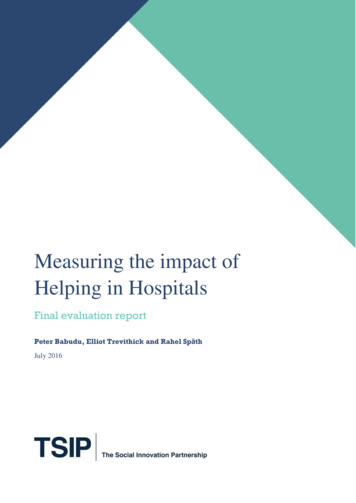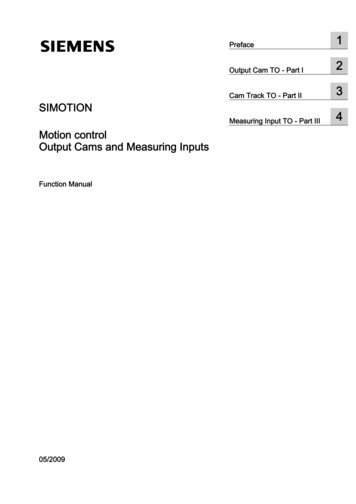
Transcription
Measuring the impact ofHelping in HospitalsFinal evaluation reportPeter Babudu, Elliot Trevithick and Rahel SpäthJuly 2016
CONTENTSExecutive summary .3Introduction .4Methods .5Research question. 5Key principles behind our approach. 5Research design . 5Limitations of the research . 8Results .10Can hospital impact volunteering help to improve patients’ experience and well-being? . 10Hospital by hospital results . 12Discussion .22Interpreting the results. 22Recommendations . 23Conclusion. 23Appendices .24Appendix 1: Helping in Hospitals Overarching Theory of Change . 24Appendix 2: Individual hospitals’ Theories of Change. 26Appendix 3: Additional detail on impact results . 37Appendix 4: Measurement tools . 442
EXECUTIVE SUMMARYThis evaluation report assesses how effective hospital impactvolunteering is at improving patient experience and well-being.The beneficiariesThe recipients of the hospital impact volunteering services were patients from ten UK hospital trusts, alarge number of whom were elderly and frail, and living with dementia.The services they receivedThe services consisted of a variety of hospital impact volunteering roles such as mealtime assistants ordementia buddies aimed at directly improving patient experience and well-being.The impact of the servicesCan hospital impact volunteering help improve patients’ experience and well-being?Quick answer: Hospital impact volunteering shows promise as a way to improve patient experience,mood, anxiety levels, nutrition and hydration, while releasing nurse time to care.Key results from the nine hospital trusts’ evaluations: Thirty per cent of all outcomes measured produced astatistically significant positive result.1 The majority of hospitals found statistically significantpositive results on patient mood, nutrition and hydrationlevels, and releasing time to care. Some hospitals found statistically significant positiveresults on patient experience and anxiety levels, while forothers no effects were found. No hospitals found any effects on re-admissions, lengthof stay, delayed transfer of care and number of falls.The table plots significant positive changes (SP), no changes(NC) and significant negative changes (SN).OutcomeSP NC SNImproved patient experience260Improved mood310Reduced readmissions040Reduced length of stay030Reduced anxiety levels220Improved nutrition levels420Improved hydration levels100Releasing time to care100Reduced delayed transfer of care010Decreased number of falls020Fig. 1 The robustness of the resultsStrengths: Given the early stage of development that many impact volunteer roles were in, we usedrelatively robust methodologies such as matched comparison group designs where possible. Also, theportfolio approach involving nine hospitals lends further credibility to the emerging evidence.1Weaknesses: The comparison designs do have limitations and, in some cases, we had to use less robustdesigns such as pre-post designs for reasons of feasibility. In addition, some of the measurement tools hadnot been tested for validity and reliability. However this evaluation’s robustness is appropriate forinterventions that are still under development.ConclusionHospital impact volunteering shows promise as a way to maintain or improve patient experience andwell-being outcomes and has the potential to relieve pressures on the healthcare system.1This figure is calculated from all outcomes measured, not just the key outcomes listed in this table. It does however not weight findings by robustness or sample size.3
INTRODUCTIONThis report details the evaluation of the Helping in Hospitals project.The primary purpose of this report is to provide an accurate picture of hospital impact volunteers’impact on patients. The report is the final output of work carried out by The Social InnovationPartnership (TSIP) for the Helping in Hospitals project, funded by the Cabinet Office and theDepartment of Health, and managed by Nesta.The report begins by introducing TSIP and the Helping in Hospitals project. It then describes themethodology used to measure the hospital impact volunteers’ impact, before presenting and discussingthe results of the research, making recommendations and offering a brief conclusion.THE SOCIAL INNOVATION PARTNERSHIPThe Social Innovation Partnership (TSIP) is a trusted advisor to public, private and social sectororganisations seeking to maximise their social impact. We believe that a strong and dynamic societywill take shape when evidence and innovation sit at the heart of efforts to tackle our most persistentsocial challenges; when evidence is used to better understand what brings about social change, andinnovation is used to find and test new solutions.THE HELPING IN HOSPITALS PROGRAMMENesta is an innovation charity with a mission to help people and organisations bring great ideas to life.It is dedicated to supporting ideas that can help improve all our lives, with activities ranging fromearly-stage investment to in-depth research and practical programmes.Nesta has worked with ten hospital trusts in England to support the creation of impact volunteeringopportunities and, with TSIP’s assistance, to look systematically at the impact of volunteers onpatients, staff and trusts. The programme ran over 18 months in two cohorts. Firstly, six hospital trustswere funded by the Cabinet Office as part of its Centre for Social Action agenda. The Department ofHealth then funded a further four hospital trusts, taking a particular interest in the involvement ofyounger volunteers, and so building on its work with youth social action in health. The age group forthis cohort was 16-25 years old.For further details on the Helping in Hospitals programme, its origin, the different types of impactvolunteering roles it included, and the wider project timelines, please refer to Nesta’s Helping inHospitals: a guide to high impact volunteering in hospitalsFor a visual overview of the variety of volunteering services provided as part of the Helping inHospitals programme and the impact these aim to have on patients, please see Appendix 1 in thisreport.4
METHODSThe hospitals collected a variety of quantitative and comparative datato better understand the impact of volunteering services on patients’hospital experience and well-being.RESEARCH QUESTIONThe evaluation aimed to answer one question: Can hospital impact volunteering help to improve patients’ experience and well-being?KEY PRINCIPLES BEHIND OUR APPROACHIn trying to answer this research question, our work was driven by three key principles: Robustness: The primary aim was to measure the impact of hospital impact volunteering withas much accuracy as possible. Proportionality: It was important that the robustness of the evaluation was proportionate tothe volunteering services’ size and stage of development. Sustainability: The evaluation needed to be resource-efficient to avoid unnecessarily takingvolunteering service and medical staff time away from patient care.RESEARCH DESIGNTo answer the question, the research took the form of an impact evaluation, using quantitative data.In all hospitals, we employed informally matched comparison group designs, where possible. Thisinvolved focusing impact volunteering on select beneficiary wards, while holding off impactvolunteering on other wards until the research could establish its actual impact and benefits. Sincemany of the volunteering services had not expanded volunteer exposure to all wards at the start of theproject, comparison groups were deemed to be ethical by all stakeholders.The beneficiary and comparison groups typically consisted of separate wards that, according to thehospitals, were as similar to each other as possible in terms of size, patient demographics, and thetypes of conditions they cared for. In some cases, a patient survey question was used instead of havingbeneficiary and comparison groups on separate wards to determine whether a patient had hadinteractions with the impact volunteers or not.For some outcomes, however, a comparison group was not feasible, and we used pre-post approachesinstead.The evaluation involved two separately funded hospital cohorts. It began with six Cabinet Officefunded hospital trusts in April 2014, and expanded to include four Department of Health-fundedhospitals focused on young volunteers in April 2015 (see table below). We used Theories of Change todetermine what outcomes should be measured for each hospital, while seeking to align outcomemeasurement as much as possible across hospitals. Data collection began in November 2014 and June2015, respectively, and ended in December 2015 and March 2016, respectively (see Figure 1).5
Cabinet Office-funded hospital trustsDepartment of Health-funded hospital trusts Barts Health NHS Trust Cambridge University Hospitals (CUH) NHSFoundation TrustThe Princess Alexandra Hospital NHSTrust Derbyshire Community Health Services NHSTrustRoyal Free London NHS FoundationTrust University Hospital Southampton NHSFoundation Trust Western Sussex Hospitals NHSFoundation Trust Great Western Hospitals NHS Foundation Trust Kingston Hospital NHS Foundation Trust Sheffield Teaching Hospitals NHS FoundationTrustFigure 1. Helping in Hospitals evaluation timelineOctober6 hospital evaluation plansare finalisedNovember6 hospitals startdata collectionAprilTSIP adds an additional 4hospitals (Young People Helpingin Hospitals) funded byDepartment of Health2014AprilTSIP designs outcomes framework for 6hospitals (Helping in Hospitals) funded byCabinet OfficeDecember6 hospitals finish datacollectionMarch4 hospitals finishdata collection2015May4 hospitalevaluationplans arefinalisedMay/JuneTSIP reportsevaluation results2016June4 hospitalsstart datacollectionDecember1 hospitaldrops outApril/MayTSIP analyses dataof 9 hospitalsOutcomes and measurement toolsThe evaluation used a variety of quantitative measurement tools to measure a diverse set of patientcentred outcomes, depending on what was appropriate for each outcome and what data were feasiblefor hospitals to collect. See Appendix 1 for the project-level Theory of Change and Table 2 (overleaf)for an overview of the key outcomes measured and main measurement tools employed.6
Table 2. Measurement tools overviewOutcomeImproved patientexperience #Improved mood #ReducedreadmissionsReduced length ofstayReduced anxietylevels #Improvednutrition levels #Improvedhydration levels #Releasing time tocareReduced delayedtransfer of careDecreasednumber of fallsMore patientvoices heardToolThe Friends & Family Test (FFT): Routine question “How likely are youto recommend our ward to friends and family if they needed similar care ortreatment?"Smiley face pictorial scale: “Please circle the number you think bestreflects your mood”Readmission rates: Due to data limitations, a proxy of total readmissions,admissions and discharges data was used.Routine Length of Stay data: Number of days of patient stayAnxiety surveys: “Do you feel you got enough emotional support fromhospital staff during your stay?” or “Do you feel confident and safe in ourcare?”Nutritional intake: Weight, calories and protein, or proportion of mealconsumed.Mealtime experience proxy: “We would like you to think about yourexperience of food on the ward. Did you get enough help from staff to eatyour meals?”)Mealtime experience proxy: “Do you always get the help you need todrink?”Nurse survey: “As an overall percentage (%) of your working time, overthe last week how long did you spend carrying out the following groups oftasks?”, distinguishing between skilled and unskilled tasks. “If a volunteerassisted you during the last week on the ward, did you find this helpful?”Routine Delayed Transfer of Care (DTOC) data: Number of patientsfacing a DTOCRoutine falls data: Time, date, ward location and harm caused for eachfall.Patient survey: Number of patient surveys or counting the number ofpatient complaints.# Data for these outcomes were in some cases collected by the volunteers themselves – see limitations section below.Please refer to Appendix 4 for additional information about these tools.Data collection processData collection differed by outcome and hospital, with our primary concern to optimise data qualitywhile minimising disruption to service delivery. Each hospital volunteering service had an evaluationlead within their team to drive evaluation planning and coordinate data collection activities with otherhospital staff. The evaluation leads often worked in collaboration with the hospitals’ businessintelligence teams and related research teams, where possible, to gain access to routine oradministrative data and ensure data collection fitted smoothly alongside existing data collectionactivities. Once the data was collected, it was sent to TSIP for analysis. None of the data includedconfidential information and therefore data sharing was straightforward.In addition to the impact data, we have gathered contextual information through focused conversationswith each hospital trust to inform the interpretation of the results.7
Data analysisDepending on the outcome data available, we used one of the three below analysis approaches, inorder of robustness:1. Difference-in-difference: Where a true baseline was available – for example, in cases wherenew impact volunteering roles were trialled – difference-in-difference analyses were used todetermine whether the patient outcome changes in the beneficiary wards differed from thepatient outcome changes in the comparison wards. This is the most robust approach.2. Beneficiary group vs comparison group: Where no true baseline was available due to preexisting impact volunteering on the beneficiary wards, independent t-tests were used todetermine whether impact volunteering has had an effect on patients in the beneficiary grouprelative to the comparison group. This is a less robust approach and results should beinterpreted with caution.3. Before vs after intervention: Where no comparison group was available, dependent t-testswere used to determine whether patients’ outcomes changed between before and after theimpact volunteering interaction. This is the least robust approach and results should beinterpreted with caution.ParticipantsThe evaluation initially included ten hospitals – six hospitals through Cabinet Office funding and fourhospitals that focused on young volunteers through Department of Health funding. One of the fourhospitals was unable to gather appropriate data for the project and it was therefore not included in theevaluation.Data was collected predominantly on wards with a large proportion of elderly and frail patients, oftenwith considerable prevalence of dementia. Since patients’ average length of stay on the evaluationwards was less than 30 days, patients usually provided just one data point. The evaluation thereforeinvolved a patient population with considerable turnover. The exceptions to this are the cases wherepatients were followed up with on a specific outcome as part of a pre-post design.LIMITATIONS OF THE RESEARCHThe employed evaluation methodology has the following limitations: Imperfect counterfactual: While hospitals have done their best to identify optimalcomparison wards, there is no guarantee that they were sufficiently comparable. Changes towards after trial start sometimes affected the counterfactual’s comparability. Randomisationwas not feasible due to practical constraints (such as too low numbers of wards) and wasdeemed inappropriate by the volunteering services whose aim it was to support those patientsmost in need. In short, the differences between patient outcomes in beneficiary wards andcomparison wards cannot solely be attributed to the impact volunteers, but instead otherfactors, such as patient demographics or differential staff pressures, may have influenced thatdifference in patient outcomes. No counterfactual: In some cases, no comparison group was feasible and we employed a prepost design instead. This has the same drawbacks as the above, although more severe. No baseline: In some cases, where impact volunteers had already been active prior to the startof the project, no true baseline was available. The analysis therefore could not compareoutcomes changing over time and instead simply compares beneficiary wards with comparisonwards.8
Untested measurement tools: While some data (such as Length of Stay) are straightforward,other measurement approaches were not. The surveys in particular should ideally be tested forreliability and validity, which was not possible during the timeframe of the evaluation. Reach: For some outcomes (e.g. patient experience), data was collected from all patients on agiven ward regardless of whether they had interacted with an impact volunteer or not. Thiswas partially because of what was deemed feasible for data collection (e.g. FFT data is alreadyroutinely collected but does not often assess whether the patient actually had a volunteerinteraction), and partially to include the effect of volunteers on the wider ward atmosphere,but may cause us to underestimate the effect of impact volunteering where less than a majorityof volunteers had interactions with the volunteers. Contamination: In some cases, volunteers ended up supporting some comparison grouppatients and therefore likely diluted the observable impact in the data. Risk of response bias: Some data were collected directly by the volunteers, due to lack of afeasible alternative, and are therefore at risk of some bias as patients may have provided morepositive responses than if the volunteer was not present.9
RESULTSHospitals detect positive effects for patient experience, mood, anxietylevels, nutrition and hydration, and releasing nurse time to care.CAN HOSPITAL IMPACT VOLUNTEERING HELP TOIMPROVE PATIENTS’ EXPERIENCE AND WELL-BEING?Portfolio-level resultsResults from the nine hospital trusts’ evaluations reveal the following:1. Thirty per cent of all outcomes measured produced a statistically significant2 positive result.32. Of those hospital trusts that measured patient mood, nutrition and hydration levels andreleasing time to care, the majority found statistically significant positive results while forthe remaining hospital trusts no effects were found.3. Of those hospital trusts that measured patient experience and anxiety levels, some of thehospital trusts found statistically significant positive results, while for others no effects werefound.4. Of those hospital trusts that measured readmissions, length of stay, delayed transfer of careand number of falls, no effects were found.5. No hospital trusts found any statistically significant negative effects.Table 3 (overleaf) provides an overview of the key results the nine hospital trusts produced for each ofthe core outcomes. It uses the following key: Dark green (SP): Statistically significant positive change Light green (NSP): Positive change but statistical significance test was not possible Yellow (NC): No statistically significant change, positive or negative Grey (blank): The outcome was not measured by this hospitalNo outcomes showed a negative change that was statistically significant.2Statistically significant at the level of 0.05, which means that we can be at least 95% sure the change was not purely due to chance. Setting the level at 0.05 is standardpractice.3Note that this figure is calculated from all outcomes measured, not just the key outcomes listed here. It does however not weight findings by robustness or sample size.10
Table 3. Overview of results of the Helping in Hospitals evaluationOriginal Helping in Hospitals cohort (Cabinet Office)OutcomeBartsImproved patient experience SPImproved moodCambridge DerbyshireGreatWesternKingston SPSPSPNCNCNSPSPReduced readmissionsReduced length of stayNCReduced anxiety levelsSPImproved nutrition levelsNCNCNCNCNCSPSPSPImproved hydration levelsReleasing time to careYoung People cohort (DH)NCNCNCNCSPSPNCNCSPSPReduced delayed transfer ofcareNCDecreased number of fallsMore patient voices heardNCNCNSPHow did service delivery and data collection issues affect the evaluation?The following information was gathered in conversation with the hospital trusts to better understandhow service delivery and practical data collection issues may have affected the evaluation.Service delivery factors: Volunteer management: Volunteers needed to be reliably present (where they are expected),present in sufficient concentration (rather than thinly spread), and well managed (sufficientoversight and allocated according to abilities), in order to have the best impact. Generally,large numbers of volunteers encouraged higher impact, but there was also a saturation level atwhich point increasing volunteer numbers did not necessarily result in an increase in impact. Referral issues: Increasing the number of patient referrals was one of the biggest problems –it slowed down the delivery of the service and meant fewer patients received volunteer supportand consequently less data was available for the evaluation. Gathering momentum: Receiving PR and external attention tended to boost volunteeringactivity (e.g. higher recruitment numbers). Pressure on hospital beds: Hospital-wide pressures on length of stay meant patients mayhave been discharged before medically fit as there is insufficient support capacity. This mayhave made readmissions more likely. Pressure on staff: Staffing pressures frequently meant that less data were collected to ensurecore services delivery.11
Caveats for the data: Noise in the data: A multitude of factors influenced the measured patient outcomes andisolating the impact of the volunteers is extremely challenging. External dependencies: The volunteering service often cannot influence Length of Stay orDelayed Transfer of Care because these outcomes depend on the availability of care packagesbeyond the control of the volunteering service. Levels of need: Patients or wards selected for the treatment group often had higher levels ofneed for support than comparison patients or wards, potentially causing the evaluation tounderestimate the effectiveness of impact volunteering. Measurement issues: Some measurement tools were less suitable than hoped for and willneed to be improved to better capture impact. For instance, many tools struggled with a‘ceiling effect’ – where outcomes are already close to optimal at baseline (e.g. FFT scoresbeing close to 100%) – making further improvement on such outcomes extremely challenging. Data from the most vulnerable: The most vulnerable patients who are elderly, frail or veryunwell were the least likely to fill in tools and may therefore be under-represented in thepresent evaluation. In addition, they may not have been able to distinguish between help fromvolunteer and help from staff, despite volunteers wearing uniforms, which further complicateseffective evaluation of volunteering roles. Risk of response bias: Some data were collected by the volunteers (due to lack of a feasiblealternative) and is therefore at risk of bias, as patients provided the data in their presence.HOSPITAL BY HOSPITAL RESULTSThis section covers the evaluation findings for each individual hospital, alongside a brief overview ofthe results, an explanation of the wider context affecting the evaluation, and a table with thesummarised quantitative results.The tables include each outcome for the relevant hospital; the average change in that outcome; the pvalue, indicating whether the result is statistically significant or not; and the analysis approach used tomeasure it. The latter is numbered to indicate the robustness of the approach (1 being the most robust).The tables use the following key similar to the above for the p-values: Dark green: Statistically significant4 positive change (starred) Yellow: No statistically significant change, positive or negativeNo outcomes showed a negative change that was statistically significant.The tables use the following key for the direction of change in each outcome: Dark green (p): Positive change Yellow (x): No change Red (n): Negative changeCaution: Only results with statistical significance are true effects, regardless of the direction of thechange in the outcome the tables may indicate.4Statistically significant at the level of 0.05, which means that we can be at least 95% sure the change was not purely due to chance. A 0.05 level is standard practice.12
Cabinet Office-funded hospitals1. Barts Health NHS Trust Impact volunteers had a statistically significant positive influence on mood and distress indementia patients, patient and nurse satisfaction with volunteer support, and the time nursesspend on unskilled tasks. The positive impact on the dementia patients and nurse satisfactionmatches the hospital trust’s observation that dementia volunteers were well received byclinical staff due to the fact that the roles and measurement tools were very closely codesigned with the clinical Dementia and Delirium team. According to the trust, volunteers aremeeting dementia nurses during their training and therefore gain more confidence to act aspart of the dementia team. In addition, posters and staff guidance are used to remind staff howvolunteers can support the trust and what support they need from trust staff, which may havecontributed to nurse satisfaction with the volunteer support. No effects were found for overall patient experience, length of stay, nurses’ satisfaction of thehospital’s care, and time nurses spend on skilled tasks. Wider context: With regard to length of stay, Barts Health have a number of ongoing Lengthof Stay-reducing projects and did not expect to see much related impact from the volunteerson their own. Also, Length of Stay data can be deceiving in cases where a stay ends due todeath, rather than successful discharge, so they need to be interpreted with caution. Lastly,pressures caused by being put under special measures in May 2015 resulted in less capacityfor data collection and thus lower sample sizes.Table 4. Quantitative impact results for Barts Health NHS TrustOutcomeOutcome changep-valueAnalysis approachImproved patient experience (FFT) - % of patients recommending-0.19% (n)this hospital’s care0.1911. Difference-indifferenceImproved mood in dementia patients (between 0-100%)20.00% (p) 0.001*3. Before vs afterinterventionReduced distress in dementia patients (between 7 and 32 points)-1.76 (p) 0.001*3. Before vs afterinterventionReduced length of stay (in days)-2.59 (p)0.00951. Difference-indifferenceImproved patient satisfaction with volunteer support (% ofpatients satisfied)10.24% (p)0.010*2. Beneficiary groupvs comparison groupImproved nursing staff satisfaction with volunteer support (% ofnurses satisfied)59.12% (p) 0.001*2. Beneficiary groupvs comparison groupImproved nursing staff experience (FFT) - % of nursesrecommending this hospital’s care-0.75% (n)0.7712. Beneficiary groupvs comparison groupReleasing time to care (% of nurse time spent on tasks that require1.00% (p)a trained nurse)0.5412. Beneficiary groupvs comparison groupReleasing time to care (% of nurse time spent on tasks that do notrequire a trained nurse)0.019*2. Beneficiary groupvs comparison group-4.00% (p)The analysis revealed that the treatment and comparison groups were not sufficiently comparable in terms of average length of stay at baseline – before the volunteeringwas fully implemented (see page 19 for the difference between the two groups). The analysis and results are thus not sufficiently reliable. Therefore, even though this resultis technically speaking statistically significant, it cannot be accepted as a true positive effect.513
2. Cambridge University Hospitals (CUH) NHS Foundation Trust Impact volunteers had a statistically significant positive influence on patient nutrition and apositive (non-significant) influence on number of patient voices heard. According to thehospital, mealtime training involved their senior dietician and wa
Reduced anxiety levels 2 2 0 Improved nutrition levels 4 2 0 Improved hydration levels 1 0 0 Releasing time to care 1 0 0 Reduced delayed transfer of care 0 1 0 Decreased number of falls 0 2 0 Strengths: Given the early stage of development that many impact volunteer roles were in, we used










